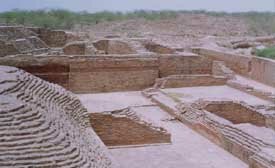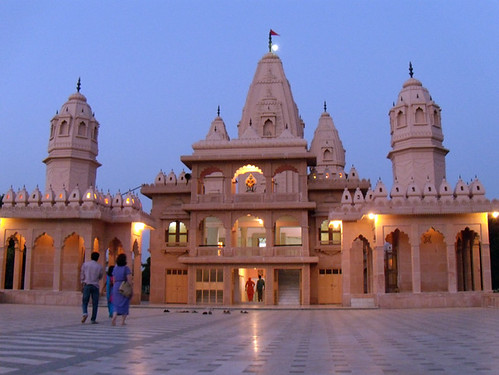Hisar city is the administrative headquarters of Hisar district, in the state of Haryana, in northwestern India. Hisar is India's largest galvanized iron manufacturing city. Due to presence of a large steel industry, it is also known as The City of Steel. Hisar was founded in 1354 AD, as Hisar-e-Firoza by Firoz Shah Tughlaq, who reigned over the Sultanate of Delhi from 1351 to 1388. Firoz Shah also brought the waters of the Yamuna river here by means of canal.The city has been inhabited by humans since pre-Harappan period as is visible from the excavations at Rakhigarhi, Siswal and Lohari Ragho.
How to reach here:
By Air: India Gandhi International airport at Delhi is the nearest airport.
By Rail: Hisar railway junction is a major railway station which is well connected to major cities of India.
Best time to visit: October to March
Languages spoken: Hindi, Haryanvi, Bagri,Urdu and English.
Must eat: Sweets.
Famous Restaurants: Lazeez, Utsav, Rasoi.
Places you must visit:
The Bishnoi Temple is also known as Asthdham, a holy place where the Bishnoi Guru Jambeshwar Ji lived or visited. The huge shrine is white painted symbolizing peace and serenity. The temple reiterates the principles laid down by the Guru. The holy words (Guru Vani) are repeated, Hawan (holy fire) is performed, bhajans are sung and Aarti is done in the temple every day. Bishnoi literature is available in the temple premises.

Feroze Shah's palace & Fort is a grand structure complete with a tehkhana (underground chambers) and a mosque. Close to the mosque lies a mound which is believed to house the ruins of probably the Harrappan civilisation.

Lat Ki Masjid was built by Feroze Shah Tughlaq is an outstanding example of the marriage of many different styles. The slightly slanting walls are characteristic of Suljuk style while the jalis (grids) are assimilated from the Hindus. A unique mosque, it is distinguished by its lithic pillar and square chamber, not to mention the shape of the mosque itself. The mosque is built in an L shape, never seen earlier.
.jpg)
Humayun's Mosque was build by this emporor in Hisar.He got his fellows to build a masjid at Fatehabad, a stone’s throw from main Hisar town.

Jahaz Kothi was a palace of Jahaz Sahib,the Irish who ruled Haryana in 1798. Hissar was his land, and he lived here in a magnificent palace (although not that big compared to Mughal standards). He got the mughals to make it for him, and so it has the characteristic mughal touch to it.

Gujri Mahal palace is also in ruins, but its baradari (raised platform used for social gatherings) is in comparitively good state and it is made of stone taken from the Hindu palaces and temples that the Mughals destroyed.

Jain Pillar is a tiny two-foot high pillar said to belong to the Jains who consider it sacred. The pillar has the distinctive diamond-shaped holy symbol of the Jains.
Ancient Mounds: hree mounds from the Harappan period can be found in Banawali, Kunal and Agroha. The mound in Banawali, 15kms from Fatehabad, reveals a fortified town (BC 2500 – 1700). Its inhabitants lived in brick houses and used clay pottery, beads of semi-precious stones and bangles, worshipping a mother goddess set in terracotta.The Kunal excavations are pretty similar, although they bring to light that the Harappans went through three stages of development; from pit houses to regular rectangular and square dwellings above the surface.The Agroha mound goes back to the 3rd century BC and is where Harappan coins were discovered apart from stone sculptures, terrracotta seals, iron and copper implements, shells and a host of other things.


Pranpir Badshah’s Tomb is where the remains of the spiritual teacher of Sher Bahlol (14th century AD) lie. Pranpir was a great Sufi saint who foretold that Ghiyas-ud-din Tughlaq would rule Hndustan from Delhi.

Hansi is a city in Hisar where painted Grey Wares and coins of the Yaudheya dynasty have been discovered. The Hansi fort was the stronghold of defending as well as invading rulers particularly due to its closeness to Hissar and it’s strategic location on the imperial road from Delhi to Afghanistan. Before that Hansi was the chief administrative town in Haryana, and in 1902 it became a cantonment for the British.

Prithviraj Chauhan’s Fort : Prithviraj Chauhan built a fort in Hansi to fight the Mughals who eventually captured and fortified it. They also built a mosque within the fort complex.

Barsi Gate ,built by Alauddin Khilji in Hansi, is an important defensive structure just outside the fort and is an outstanding example of how defences were built with architectural finesse. Today it stands in the centre of the bazaar, forming an imposing gate and a part of the imposing wall which forms the outer defence for Hansi. An inscription in Persian on the gate dates it back to AD 1304-5.

Dargah Char Qutub: Towards the west of the Hansi town lie four shrines in the memory of four Sufi saints, namely Jamal-ud-din Hansi (AD 1187 – 1261), Burhan-ud-din (AD 1261 – 1300), Qutub-ud-din Munawar (AD 1300 – 1303), and Nur-ud-din (AD 1325 – 1397). These were Sufi saints who were given the title of Qutubs, and this monument is the final resting place for them. The tomb itself is connected to a small mosque which in turn leads to a larger mosque built by Feroze Shah Tughlaq. There are more tombs within the complex: the tomb of Mir Tijarah (the chief purveyor of Sultan Hamid-ud-din of Hansi), Mir Alam’s tomb and that of Begum Skinner.

Agroha was the prosperous and illustrious kingdom of Maharaja Agrasen about 3000 years back. The Agroha Mound, or 'Ther' as it is locally called, is about 1.5 km away from the present AGROHA village. Buried under this mound are the remains of an ancient town and its excavation was started in the year 1888-89. It was at that time that people came to know about this great kingdom.

Thank You Sir, for this informaiton, your blog is a guide for toursit who visit the India. thanks a lot
ReplyDeleteThank you.I am glad you liked it.
Delete